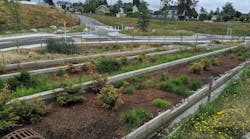Permeable Pavement Offers Environmentally Friendly Option for Parking Lot
Most people don’t consider a parking lot a thing of beauty, but the honeycomb design of some new parking lots in eastern North Carolina is easier on the environment than standard asphalt and could be considered an attractive alternative to traditional designs.
North Carolina State University researchers William F. Hunt III, an urban stormwater extension specialist in the Department of Biological and Agricultural Engineering, and John R. Stone, associate professor of civil engineering, are working to discover how well these new parking lots, constructed of permeable pavement, are performing. Permeable pavement is a multilayer construction material that allows stormwater to drain naturally through the soil below, rather than becoming runoff with the potential to contaminate soil and water with oil and other pollutants. Hunt points out that permeable pavement is really nothing new–it was first used during World War II to create airplane runways and tank roads on sandy beaches. Nicknamed “Marsh Mats” for the Marshall Islands in the Pacific, these pavements were the forerunners of the new pavements being studied at NC State. The contemporary construction technique involves layering materials to create a lot that is both permeable to water and sturdy enough to support heavy cars. A permeable geotextile fabric is spread over a base layer of gravel to keep the gravel stable but allow water to pass through it. A top layer of sand and a concrete or plastic lattice grid complete the pavement. The final step is to plant a spreading variety of grass, such as Bermuda grass, to add further stability and texture. Initially these permeable pavement lots cost a little more than conventional lots to construct. According to Hunt, however, “The total cost could be less because permeable pavement may reduce the amount of money put into infrastructure such as ponds and storm drains.” For about two years the research group has been observing the performance of a permeable pavement they installed for a parking lot at the Hannibal Building in Kinston, NC. The lot contains 26 spaces and was designed by NC State civil engineering students in spring 1999. So far it has performed well; it is still in good condition, with no evidence of runoff contaminating the surrounding area. This January, civil engineering undergraduate students Jamey T. Westmoreland of Huntersville, Jason A. Houston of Jacksonville, and Eric T. Taylor of Raleigh decided to design, as their senior project, a similar parking lot at Wilmington’s Legion Stadium, which is near Greenfield Lake and Gardens, a popular park and nature reserve set around a 158-ac. lake. The students created a proposal for putting in a combination conventional and permeable lot that would enable researchers to compare the effects of the two types of pavement. Half the lot is standard asphalt and the other half is Grasspave, which is a set of interlocking plastic rings patented by Invisible Structures Inc. of Aurora, CO. The researchers hope to observe this lot for several years to study its performance, as they have with the Kinston lot.
If these studies indicate long-term high performance both structurally and environmentally, permeable pavement could become a common sight–one certainly more attractive and gentler on the environment than the miles of asphalt currently in use.

